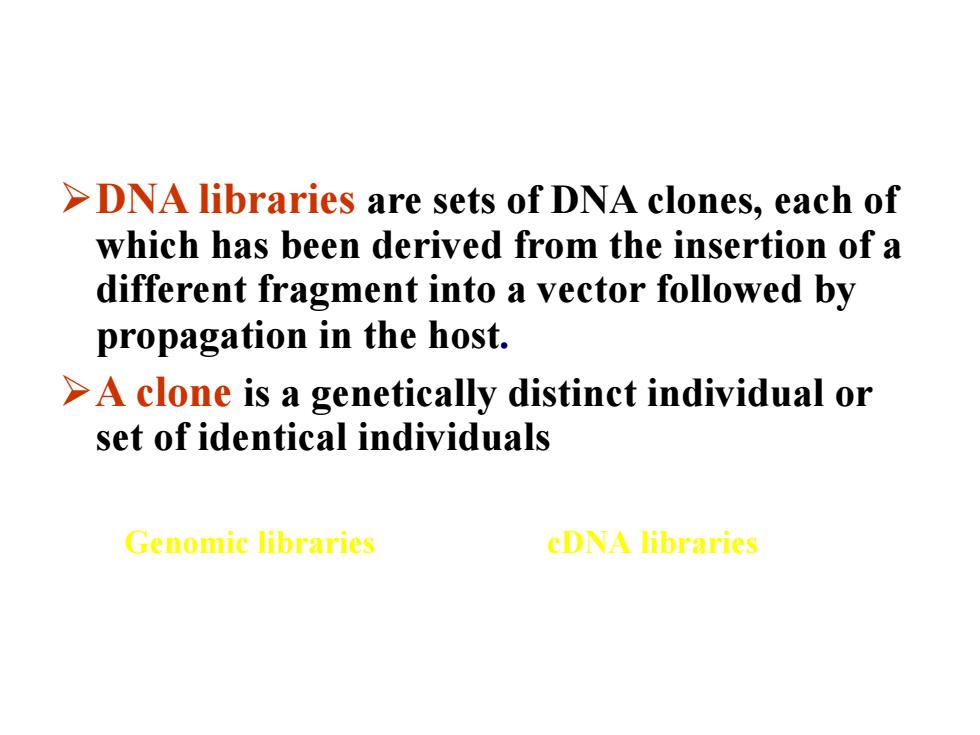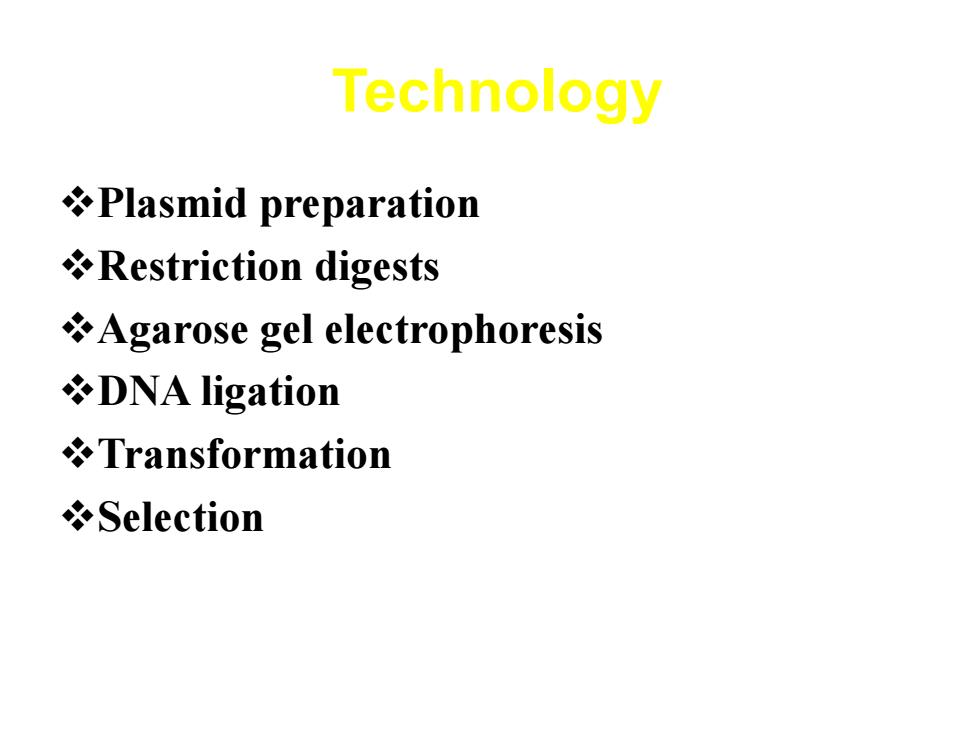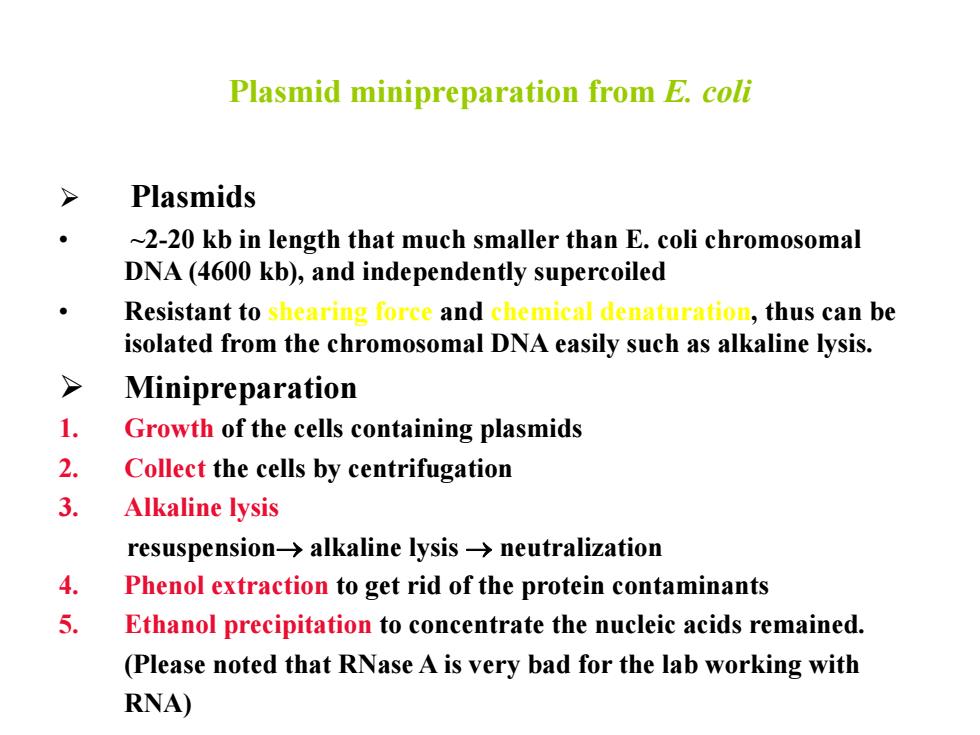
ØDNA libraries are sets of DNA clones, each of which has been derived from the insertion of a different fragment into a vector followed by propagation in the host. ØA clone is a genetically distinct individual or set of identical individuals Genomic libraries cDNA libraries
ØDNA libraries are sets of DNA clones, each of which has been derived from the insertion of a different fragment into a vector followed by propagation in the host. ØA clone is a genetically distinct individual or set of identical individuals Genomic libraries cDNA libraries

Genomic libraries prepared form random fragments of genomic DNA, which may be inefficient to find a gene because of the huge abundance of the non-coding DNA cDNA libraries DNA copies (cDNA) synthesized from the mRNA by reverse transcription are inserted into a vector to form a cDNA library. Much more efficient in identifying a gene, but do not contain DNA coding functional RNA or noncoding sequence
Genomic libraries prepared form random fragments of genomic DNA, which may be inefficient to find a gene because of the huge abundance of the non-coding DNA cDNA libraries DNA copies (cDNA) synthesized from the mRNA by reverse transcription are inserted into a vector to form a cDNA library. Much more efficient in identifying a gene, but do not contain DNA coding functional RNA or noncoding sequence

Technology vPlasmid preparation vRestriction digests vAgarose gel electrophoresis vDNA ligation vTransformation vSelection
Technology vPlasmid preparation vRestriction digests vAgarose gel electrophoresis vDNA ligation vTransformation vSelection

Preparation of plasmid DNA Plasmids: small, extrachromosomal circular molecules, from 2 to ~200 kb in size, which exist in multiple copies within the host cells. Characters: contain an origin of replication and replicate independently Usually carry a few genes, one of which may confer resistance to antibacterial substance. Example: ampr gene encoding the enzyme b-lactamase which degrades penicillin antibiotics such as ampicillin
Preparation of plasmid DNA Plasmids: small, extrachromosomal circular molecules, from 2 to ~200 kb in size, which exist in multiple copies within the host cells. Characters: contain an origin of replication and replicate independently Usually carry a few genes, one of which may confer resistance to antibacterial substance. Example: ampr gene encoding the enzyme b-lactamase which degrades penicillin antibiotics such as ampicillin

Plasmid minipreparation from E. coli Ø Plasmids • ~2-20 kb in length that much smaller than E. coli chromosomal DNA (4600 kb), and independently supercoiled • Resistant to shearing force and chemical denaturation, thus can be isolated from the chromosomal DNA easily such as alkaline lysis. Ø Minipreparation 1. Growth of the cells containing plasmids 2. Collect the cells by centrifugation 3. Alkaline lysis resuspension alkaline lysis neutralization 4. Phenol extraction to get rid of the protein contaminants 5. Ethanol precipitation to concentrate the nucleic acids remained. (Please noted that RNase A is very bad for the lab working with RNA)
Plasmid minipreparation from E. coli Ø Plasmids • ~2-20 kb in length that much smaller than E. coli chromosomal DNA (4600 kb), and independently supercoiled • Resistant to shearing force and chemical denaturation, thus can be isolated from the chromosomal DNA easily such as alkaline lysis. Ø Minipreparation 1. Growth of the cells containing plasmids 2. Collect the cells by centrifugation 3. Alkaline lysis resuspension alkaline lysis neutralization 4. Phenol extraction to get rid of the protein contaminants 5. Ethanol precipitation to concentrate the nucleic acids remained. (Please noted that RNase A is very bad for the lab working with RNA)